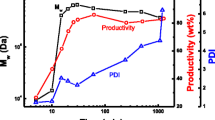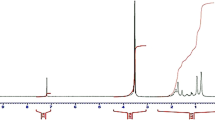Abstract
3-[2-(N-methylacrylamido)-ethyldimethylammonio] propanesulfonate (MAEDAPS), a novel zwitterionic monomer, was designed and synthesized in this study. Then it reacted with acrylamide and N, N-dimethyl acrylamide by free radical polymerization in aqueous solution with ammonium persulfate ((NH4) 2S2O8) and sodium sulfite (NaHSO3) as initiator. The structure of MAEDAPS was characterized by 1H NMR and IR. Thermal stability of the obtained copolymer was tested by DSC, TGA and TG-IR analysis. Glass transition temperature (Tg) and melt temperature (Tm) was observed by DSC, meanwhile, the thermal degradation process was studied via TGA and TG-IR. It turned out that the thermal degradation process can be divided into three stages including removal of physically absorbed water, decomposition of side groups and degradation of polymer main chain. Anti-polyelectrolyte behavior was observed based on the intrinsic viscosity. Solution properties of ternary copolymer were exhibited by reduced viscosity. The result showed that the addition of small molecular electrolytes weakened the coulomp attraction between sulfonic acid group and quaternary ammonium group, and the conformation became extend, which led to the increase of hydrodynamic volume and reduced viscosity. The ability of monovalent and divalent cationic charges influencing the viscosity of zwitterionic copolymer obeyed the following sequence: K+ < Li+ < Na+, Cu2+ < Ca2+ < Mg2+, and anions was in the order: Cl−< I−< Br−.
















Similar content being viewed by others
References
Tan BH, Ravi P, Tam KC (2006) Synthesis and characterization of novel pH-responsive polyampholyte microgels. Macromol Rapid Commun 27(7):522–528. doi:10.1002/marc.200500830
He L, Wang S, Liu X, Wang C, Chao D (2013) Synthesis and properties of a novel multifunctional hyperbranched polyamide. J Polym Res 20(8):1–8. doi:10.1007/s10965-013-0214-5
Kathmann EEL, Davis DD, McCormick CL (1994) Water-soluble polymers. 60. Synthesis and solution behavior of terpolymers of acrylic acid, acrylamide, and the zwitterionic monomer 3-[(2-acrylamido-2-methylpropyl) dimethylammonio]-1-propanesulfonate. Macromolecules 27(12):3156–3161. doi:10.1021/ma00090a007
Liaw D-J, Huang C-C, Sang H-C, Wu P-L (2000) Macromolecular microstructure, reactivity ratio and viscometric studies of water-soluble cationic and/or zwitterionic copolymers. Polymer 41 (16):6123–6131. doi:http://dx.doi.org/10.1016/S0032-3861(99)00824-1
Sonnenschein L, Seubert A (2011) Synthesis of a series of monomeric styrene sulfobetaine precursors. Tetrahedron Letters 52 (10):1101–1104. doi:http://dx.doi.org/10.1016/j.tetlet.2010.12.100
Bonte N, Laschewsky A (1996) Zwitterionic polymers with carbobetaine moieties. Polymer 37 (10):2011–2019. doi:http://dx.doi.org/10.1016/0032-3861(96)87319-8
Kazantsev O, Shirshin K, Sivokhin A, Igolkin A, Goncharova O, Kamorin D (2012) Copolymerization of sodium 2-acrylamido-2-methylpropane sulfonate with acrylamide and acrylonitrile in water: an effect of conditions on the compositional heterogeneity. J Polym Res 19(6):1–10. doi:10.1007/s10965-012-9886-5
McCormick CL (1985) Water-soluble random and graft copolymers for utilization in enhanced Oil recovery. J Macromol Sci A Chem 22(5–7):955–982. doi:10.1080/00222338508056647
Wang H, Wei J, Li S, Chen Y, Ren Z, Qiu S (2012) Preparation and characterization of AA/AMPS grafted polypropylene by two-steps electron beam irradiation for filtration of cigarette smoke. J Polym Res 20(1):1–6. doi:10.1007/s10965-012-0044-x
Kostova B, Kamenska E, Rachev D, Simeonova S, Georgiev G, Balashev K (2013) Polyzwitterionic copolymer nanoparticles loaded in situ with metoprolol tartrate: synthesis, morphology and drug release properties. J Polym Res 20(2):1–8. doi:10.1007/s10965-012-0060-x
Zhang Y, Wang L, Li X, He P (2011) Salt-resistant superabsorbents from inverse-suspension polymerization of PEG methacrylate, acryamide and partially neutralized acrylic acid. J Polym Res 18(2):157–161. doi:10.1007/s10965-010-9402-8
Kim G, Yong Y, Kang HJ, Park K, Kim SI, Lee M, Huh N (2014) Zwitterionic polymer-coated immunobeads for blood-based cancer diagnostics. Biomaterials 35(1):294–303. doi:10.1016/j.biomaterials.2013.09.101
Lin W, Ma G, Chen S (2013) Evasion of the accelerated blood clearance phenomenon of colloidal carriers by using zwitterionic star polymers as shell materials. J Control Release Off J Control Release Soc 172(1):e73–e73. doi:10.1016/j.jconrel.2013.08.150
Mi L, Jiang S (2014) Integrated antimicrobial and nonfouling zwitterionic polymers. Angew Chem Int Ed 53(7):1746–1754. doi:10.1002/anie.201304060
Johnson KM, Poe GD, Lochhead RY, McCormick CL (2004) The synthesis of hydrophobically modified water‐soluble polyzwitterionic copolymers and responsiveness to surfactants in aqueous solution. J Macromol Sci A 41(6):587–611. doi:10.1081/MA-120034192
Lalani R, Liu L (2011) Synthesis, characterization, and electrospinning of zwitterionic poly (sulfobetaine methacrylate). Polymer 52(23):5344–5354
Kudaibergenov S, Jaeger W, Laschewsky A (2006) Polymeric Betaines: Synthesis, Characterization, and Application. In: Supramolecular Polymers Polymeric Betains Oligomers, vol 201. Advances in Polymer Science. Springer Berlin Heidelberg, pp 157–224. doi:10.1007/12_078
Lee W-F, Tsai C-C (1994) Synthesis and solubility of the poly (sulfobetaine) s and the corresponding cationic polymers: 1. Synthesis and characterization of sulfobetaines and the corresponding cationic monomers by nuclear magnetic resonance spectra. Polymer 35(10):2210–2217
An H, Lu C, Wang P, Li W, Tan Y, Xu K, Liu C (2011) A novel hydrophobically associating polyampholytes of poly (AM/AA/AMQC12): preparation, characterization, and solution properties. Polym Bull 67(1):141–158. doi:10.1007/s00289-011-0465-4
Ning J, Kubota K, Li G, Haraguchi K (2013) Characteristics of zwitterionic sulfobetaine acrylamide polymer and the hydrogels prepared by free-radical polymerization and effects of physical and chemical crosslinks on the UCST. Reactive and Functional Polymers 73 (7):969–978. doi:http://dx.doi.org/10.1016/j.reactfunctpolym.2012.11.005
Han D, Letteri R, Chan-Seng D, Emrick T, Tu H (2013) Examination of zwitterionic polymers and gels subjected to mechanical constraints. Polymer 54 (12):2887–2894. doi:http://dx.doi.org/10.1016/j.polymer.2013.04.003
Kitano H, Imai M, Sudo K, Ide M (2002) Hydrogen-bonded network structure of water in aqueous solution of sulfobetaine polymers†. J Phys Chem B 106(43):11391–11396. doi:10.1021/jp020185r
Mary P, Bendejacq DD, Labeau M-P, Dupuis P (2007) Reconciling Low- and high-salt solution behavior of sulfobetaine polyzwitterions. J Phys Chem B 111(27):7767–7777. doi:10.1021/jp071995b
Gui Z, Qian J, An Q, Xu H, Zhao Q (2009) Synthesis, characterization and flocculation performance of zwitterionic copolymer of acrylamide and 4-vinylpyridine propylsulfobetaine. European Polymer Journal 45 (5):1403–1411. doi:http://dx.doi.org/10.1016/j.eurpolymj.2009.02.010
Lowe AB, McCormick CL (2002) Synthesis and solution properties of zwitterionic polymers. Chem Rev 102(11):4177–4190
Pretsch E, Bühlmann P, Badertscher M (2009) IR Spectroscopy. Structure Determination of Organic Compounds. Springer Berlin Heidelberg, In, pp 1–67. doi:10.1007/978-3-540-93810-1_7
Pretsch E, Bühlmann P, Badertscher M (2009) 1H NMR Spectroscopy. Structure Determination of Organic Compounds. Springer Berlin Heidelberg, In, pp 1–86. doi:10.1007/978-3-540-93810-1_5
Benesi HA, Hildebrand J (1949) A spectrophotometric investigation of the interaction of iodine with aromatic hydrocarbons. J Am Chem Soc 71(8):2703–2707
Coates J (2006) Interpretation of infrared Spectra, a practical approach. Encyclopedia of Analytical Chemistry. John Wiley & Sons, Ltd., In. doi:10.1002/9780470027318.a5606
Richardson MJ, Savill NG (1975) Derivation of accurate glass transition temperatures by differential scanning calorimetry. Polymer 16 (10):753–757. doi:http://dx.doi.org/10.1016/0032-3861(75)90194-9
Her L-M, Nail S (1994) Measurement of glass transition temperatures of freeze-concentrated solutes by differential scanning calorimetry. Pharm Res 11(1):54–59. doi:10.1023/A:1018989509893
Okazaki I, Wunderlich B (1997) Reversible melting in polymer crystals detected by temperature-modulated differential scanning calorimetry. Macromolecules 30(6):1758–1764. doi:10.1021/ma961539d
Freire E (1995) Differential Scanning Calorimetry. In: Shirley B (ed) Protein Stability and Folding, vol 40. Methods in Molecular Biology™. Humana Press, pp 191–218. doi:10.1385/0-89603-301-5:191
Liu J, Xu T, Han X, Fu Y (2006) Synthesis and characterizations of a novel zwitterionic hybrid copolymer containing both sulfonic and carboxylic groups via sulfonation and zwitterionic process. European Polymer Journal 42 (10):2755–2764. doi:http://dx.doi.org/10.1016/j.eurpolymj.2006.04.006
Hirose S, Kobashigawa K, Izuta Y, Hatakeyama H (1998) Thermal degradation of polyurethanes containing lignin studied by TG-FTIR. Polym Int 47(3):247–256. doi:10.1002/(SICI)1097-0126(199811)47:3<247::AID-PI966>3.0.CO;2-F
Armentrout RS, McCormick CL (1999) Water soluble polymers. 76. Electrolyte responsive cyclocopolymers with sulfobetaine units exhibiting polyelectrolyte or polyampholyte behavior in aqueous media. Macromolecules 33(2):419–424. doi:10.1021/ma991133b
Popescu I, Airinei A, Suflet D, Popa M (2011) Maleic acid–2-vinylnaphthalene copolymer in aqueous solution: investigation of the dissociation and fluorescence quenching. J Polym Res 18(6):2195–2203. doi:10.1007/s10965-011-9630-6
Jie C, Yebang T, Yuju C, Qiang M (2011) Synthesis of copolymer of acrylamide with sodium vinylsulfonate and its thermal stability in solution. J Polym Res 18(2):171–178. doi:10.1007/s10965-010-9404-6
Ezell Ryan G, Lowe Andrew B, McCormick Charles L (2006) Synthetic Polyzwitterions: Water-Soluble Copolymers and Terpolymers. In: Polyelectrolytes and Polyzwitterions, vol 937. ACS Symposium Series, vol 937. American Chemical Society, pp 47–63. doi:doi:10.1021/bk-2006-0937.ch003 10.1021/bk-2006-0937.ch003
Berlinova IV, Dimitrov IV, Kalinova RG, Vladimirov NG (2000) Synthesis and aqueous solution behaviour of copolymers containing sulfobetaine moieties in side chains. Polymer 41 (3):831–837. doi:http://dx.doi.org/10.1016/S0032-3861(99)00264-5
Chan LL, Wong KH, Smid J (1970) Complexation of lithium, sodium, and potassium carbanion pairs with polyglycol dimethyl ethers (glymes). Effect of chain length and temperature. J Am Chem Soc 92(7):1955–1963. doi:10.1021/ja00710a029
Cantwell FF, Puon S (1979) Mechanism of chromatographic retention of organic ions on a nonionic adsorbent. Anal Chem 51(6):623–632. doi:10.1021/ac50042a009
Valleau JP, Torrie GM (1982) The electrical double layer. III. Modified Gouy − Chapman theory with unequal ion sizes. The Journal of Chemical Physics 76 (9):4623–4630. doi:doi:http://dx.doi.org/10.1063/1.443542
Attard P (2001) Recent advances in the electric double layer in colloid science. Current Opinion in Colloid & Interface Science 6 (4):366–371. doi:http://dx.doi.org/10.1016/S1359-0294(01)00102-9
Author information
Authors and Affiliations
Corresponding author
Rights and permissions
About this article
Cite this article
Liu, C., Gu, X., Cui, M. et al. A novel ternary copolymerized polyzwitterionic of poly (AM/DMAM/MAEDAPS): synthesis and solution properties. J Polym Res 21, 620 (2014). https://doi.org/10.1007/s10965-014-0620-3
Received:
Accepted:
Published:
DOI: https://doi.org/10.1007/s10965-014-0620-3




